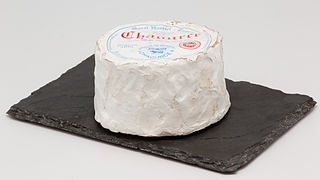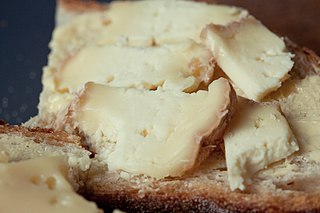
Brie is a soft cow's-milk cheese named after Brie, the French region from which it originated. It is pale in colour with a slight greyish tinge under a rind of white mould. The rind is typically eaten, with its flavour depending largely upon the ingredients used and its manufacturing environment. It is similar to Camembert, which is native to a different region of France. Brie typically contains between 60% and 75% butterfat, slightly higher than Camembert.

Camembert is a moist, soft, creamy, surface-ripened cow's milk cheese. It was first made in the late 18th century in Camembert, Normandy, in northwest France. It is sometimes compared in look, taste and texture to brie cheese, albeit with a slightly lower butterfat content than brie's typical 20% – 25% by weight.

Cheesemaking is the craft of making cheese. The production of cheese, like many other food preservation processes, allows the nutritional and economic value of a food material, in this case milk, to be preserved in concentrated form. Cheesemaking allows the production of the cheese with diverse flavors and consistencies.

Munster, Munster-géromé, or (Alsatian) Minschterkaas, is a soft cheese with a strong taste and aroma, made mainly from milk first produced in the Vosges, between the Alsace-Lorraine and Franche-Comté regions in France. The name "Munster" is derived from the Alsace town of Munster, where, among Vosgian abbeys and monasteries, the cheese was conserved and matured in monks' cellars.

Chaource is a French cheese, originally manufactured in the village of Chaource in the Champagne-Ardenne region.

Comté is a French cheese made from unpasteurized cow's milk in the Franche-Comté region of eastern France bordering Switzerland and sharing much of its cuisine. Comté has the highest production of all French Appellation d'origine contrôlée (AOC) cheeses, at around 65,000 tonnes annually. It is classified as an Alpine cheese.

Cantal cheese is an uncooked firm cheese produced in the Auvergne region of central France: more particularly in the département of Cantal as well as in certain adjoining districts. Cantal cheese was granted Appellation d'Origine Contrôlée certification in 1956. One of the oldest cheeses in France, Cantal dates back to the times of the Gauls. It came to prominence when Marshal Henri de La Ferté-Senneterre served it at the table of Louis XIV of France. Senneterre is also responsible for the introduction of Saint-Nectaire and Salers.

Ardrahan Farmhouse Cheese creates two varieties of cheese. They originate from Ardrahan Farmhouse, Kanturk, County Cork in Ireland. The two varieties are Ardrahan and Duhallow. Eugene and Mary Burns first made Ardrahan cheese on their farm in County Cork in 1983 using traditional techniques. Both varieties are made entirely from the milk of the Burnses' cow herd, which is composed of Friesian cows.

Pont-l'Évêque is a French cheese, originally manufactured in the area around the commune of Pont-l'Évêque, between Deauville and Lisieux in the Calvados département of Normandy. It is probably the oldest Norman cheese still in production.

Salers is a French semi-hard cheese originating from Salers, in the volcanic region of the Cantal mountains of the Massif Central, Auvergne, central France. It is a pressed, uncooked cheese, sometimes made from Salers cow's milk, between 15 April and 15 November. It is circular in shape, formed in rounds weighing around 40 kilograms (88 lb). The cheese is aged in caves at temperatures ranging from 6–12 °C (43–54 °F) for a minimum of 3 months, and up to 45 months.

Laguiole, sometimes called Tome de Laguiole, is a pressed uncooked French cheese from the plateau of Aubrac, situated at between 800 - 1400m, in the region of Aveyron in the southern part of France. It takes its name from the small town of Laguiole and has been protected under the French Appellation d'Origine Contrôlée (AOC) since 1961 and a Appellation d'origine protégée since 1996. Laguiole is said to have been invented at a monastery in the mountains of Aubrac in the 19th century. According to historical accounts, the monks passed down the recipe for making this cheese from cattle during the alpages to the local buronniers, the owners of burons, or mountain huts.

Shropshire Blue is a cow's milk cheese made in the United Kingdom.

Saint Agur is a blue cheese brand owned by Savencia Fromage & Dairy Group and made with pasteurised cow's milk from the village of Beauzac in the Monts du Velay, part of the mountainous Auvergne region of central France. It is made from pasteurised cow's milk, enriched with cream, and contains 60% butterfat, qualifying it as a double-cream cheese. Aged for 60 days in cellars, the cheese becomes stronger and spicier as it ages.

Cheese is a type of dairy product produced in a range of flavors, textures, and forms by coagulation of the milk protein casein. It comprises proteins and fat from milk. During production, milk is usually acidified and either the enzymes of rennet or bacterial enzymes with similar activity are added to cause the casein to coagulate. The solid curds are then separated from the liquid whey and pressed into finished cheese. Some cheeses have aromatic molds on the rind, the outer layer, or throughout.

Picodon is a goats-milk cheese made in the region around the Rhône in southern France. The name means "spicy" in Occitan.

The pallone di Gravina is a firm, semi-hard, cow's milk cheese from the regions of Basilicata and Apulia, in south-east Italy. It is made in the pasta filata style weighing between 1.5 and 2.5 kg, in a pear-like shape, ball or balloon (pallone), and was traditionally produced in the area of the city of Gravina, in the Murgia area of the province of Bari. Today, however, production is centred on the province of Matera.

Flor de Guía cheese is a Spanish cheese made on the island of Gran Canaria in the Canary Islands. It has Denomination of Origin protection. The cheese is classified as fatty or semi-fatty and made from the milk from Canarian sheep, with milk from Canarian cows and/or goats. The milk from the sheep must constitute at least 60% and cows’ milk content must never exceed 40%. Goat milk must never exceed 10% of the mixture. The cheese is presented in flat cylindrical cheeses which normally measure 4–8 cm high and 20–30 cm across and weighing between 2 and 5 kg. The cheese gets its name from an area in northern Gran Canaria called Santa María de Guía, where the cheese is made, and ‘flor’ from the fact that juice from the flowerheads of a species of cardoon and globe artichoke are used to curdle the milk.
Béal Organic Cheese is made by Kate Carmody at Béal Lodge Dairy Farm, a small family-run dairy farm of Holstein cows on 56 acres located by the mouth of the River Shannon in Listowel, County Kerry in Ireland. It is a cheddar cheese and claims to be the first Irish produced using organic farming and methods. Béal Organic Cheese is handmade from cow's milk.

Tome des Baugespronounced[tɔmdeboʒ] is a variety of Tomme cheese made in the Bauges mountains in the French Alps, in the Savoie department of the Auvergne-Rhône-Alpes region.





















